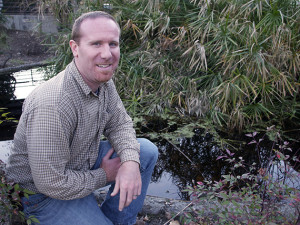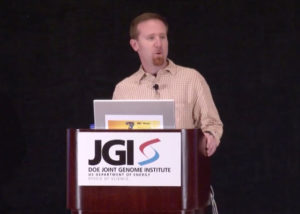-

Matthew Sullivan, Departments of Microbiology, and Civil, Environmental and Geodetic Engineering, The Ohio State University
- Collaborated with JGI since 2001
How long have you collaborated with the JGI and on which projects?
Since 2009 as head of my own lab, and since 2001 as a PhD student (with Penny Chisholm at MIT) working on the initial marine Prochlorococcus and then cyanophage genomes.
I have been working with JGI researchers on marine cyanophages (isolate genomes) for a decade now, including a recent study designed to examine the population genome level variation of viruses that infect a single host from each of two Pacific Ocean viral communities (144 total genomes). Complementing this targeted cyanophage work, we have sought to better understand ocean viral communities and provide a “GOS-scale” [referring to Craig Venter’s Global Ocean Sampling expedition] viral metagenomic dataset (the Pacific Ocean Virome), through numerous viral metagenomes including the first metagenomic characterization of viral communities from the surface and deep ocean interior of the Subarctic Pacific Ocean (the LineP transect), the upwelling region off Monterey (the Line67 transect), and other sites around the global oceans using samples derived from each the Tara Oceans (http://oceans.taraexpeditions.org/) and Malaspina Expeditions. The two transects represent decades-old oceanographic coastal-to-open ocean surveys across upwelling regions or through expanding and climate-critical oxygen minimum zones, while the global ocean surveys are helping map viruses to fish larvae using various combinations of sequencing, imaging and biogeochemical measurements to serve as baseline data for ultimately assessing how communities might respond to climate change.
Why is this research important?
Among our goals is to develop a better understanding of how ocean cyanobacterial viruses impact global photosynthesis and other biogeochemical processes, while also revealing how viral communities are structured in nature and how they might change in response to ecological perturbations. Discoveries from this work include the knowledge that cyanophages encode core photosynthesis genes to manipulate host metabolisms during infection to make more progeny. Complementing this, the viral community genetic characterizations have recently revealed that this viral metabolic reprogramming extends to nearly all of central carbon metabolism.

Click here to watch Matt Sullivan’s talk from the DOE JGI 2012 Genomics of Energy & Environment Meeting.
What do you value about JGI’s contributions?
The JGI makes projects possible at scales about which individual labs can only dream. To really map viral diversity and evaluate viral functional roles and the underlying drivers of viral community structure requires scaling beyond “single lab” level datasets, and inventing new ways to look at such large-scale data. JGI’s expertise on data generation and analytics are invaluable for making sense of the hidden movers and shakers (microbes and viruses) in our natural world.
References: http://bit.ly/sullivan-cites
Brum, J.R. et al. Patterns and ecological drivers of ocean viral communities. Science 22 May 2015: 865-867. [DOI:10.1126/science.aaa7378]
Hurwitz, B. H. & Sullivan, M. B. The Pacific Ocean Virome (POV): a marine viral metagenomic dataset and associated protein clusters for quantitative viral ecology. PLoS One 8, e57355 (2013).
Hurwitz, B. L., Hallam, S. J. & Sullivan, M. B. Metabolic reprogramming by viruses in the sunlit and dark ocean. Genome Biol 14, R123, doi:10.1186/gb-2013-14-11-r123 (2013).
Sullivan, M. B., Coleman, M., Weigele, P., Rohwer, F. & Chisholm, S. W. Three Prochlorococcus cyanophage genomes: Signature features and ecological interpretations. PLoS Biology 3, e144 (2005).
Sullivan, M. B. et al. Genomic analysis of oceanic cyanobacterial myoviruses compared to T4-like myoviruses from diverse hosts and environments. Environ Microbiol 12, 3035-3056 (2010).
Sullivan, M. B. et al. The genome and structural proteome of an ocean siphovirus: A new window into the cyanobacterial ‘mobilome’. Environ Microbiol 11, 2935-2951 (2009).